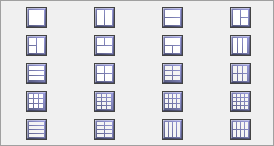The main display area of the user interface is called a page. Each page can contain from one to 16 windows. Any window on a page can display an HM model (HyperMesh), MBD model (MotionView), animation (HyperView), 2-D plot (HyperGraph), 3-D plot (HyperGraph 3D), text (TextView), or media file (MediaView).
You can create any number of pages in a session. The pages are stored in a list, enabling you to display any page at any time as well as add, cut, copy, and paste pages. Only one page is displayed at a time. The current page number and the total number of pages in the session are displayed in the upper right corner of the window.
Each page can have a different layout depending on your needs. A typical layout might consist of a large window on the left displaying an animation with two smaller windows on the right tracking relevant data points on corresponding plots. There are 20 possible page arrangements.

| Note: | The program's default layout is a single window; however a different default layout can be specified using the *SetDefaultPageLayout() statement in the .preferences.mvw file. |
|
HyperMesh panels are grouped by function on several "pages". HyperMesh presents these pages in the page menu, which is located on the right-hand edge of the main menu area.

The page menu
Each of these pages contain panels related to the page name:
Page
|
Description
|
Geom
|
Creation and editing functions for geometry such as points, lines, or surfaces
|
1D
|
1-D element creation, such as bars, masses, and spot welds
|
2D
|
Creation and editing functions for 2-D surfaces and elements
|
3D
|
Creation and editing functions for 3-D surfaces and elements
|
Analysis
|
Boundary conditions, coordinate system, and load creation functions.
|
Tool
|
Model editing, utility functions, model checking functions, and informational functions.
|
Post
|
Post-processing and xy plotting functions.
|
| Note: | If you are not using the default HyperMesh menu system, then the menu items described above may not appear on the appropriate pages. To correct this condition, quit HyperMesh, delete the file hmmenu.set from the directory you are working in (provided you are not working in the directory where HyperMesh is installed), and then start HyperMesh once again. |
|
How do I....
| 1. | Click the Page Layout button  on the toolbar. The page layout options are displayed. on the toolbar. The page layout options are displayed. |
| 2. | Double-click on a layout. The selected layout is applied to the current page and the Page Layout dialog closes. |
|
| 1. | In the Session browser, click on p1.Untitled to create a new page. |
| 2. | Right-click on any page title for the context menu. From here, you can |
| • | Cut, copy, paste, insert, or add pages. |
| • | Change the name of the page. |
| • | Change the font style, size, and type for the page name |
|
On pages that contain more than one window, individual windows can be expanded to fill the entire page by clicking the Expand Window icon  on the toolbar. on the toolbar.
Click the Reduce Window button  to return the window to its original size and position on the page. to return the window to its original size and position on the page.
Expanded windows are reduced to their original size if you turn the page.
|
Swap exchanges the active window's position with another window on the same page. For example, you could swap the upper left window with the lower right window in a six window layout.
| 2. | Click Swap  . The cursor changes to a small cross. . The cursor changes to a small cross. |
| 3. | Select a new location by clicking on another window. The first window exchanges places with the second window. |
When only two windows appear on the layout, the Swap button automatically exchanges the two windows. Swap does not work in single window layouts.
|
| 1. | Click on a window to copy. |
| 2. | From the Edit menu, select Copy and select Window. |
| 3. | Click on the window where you want to paste the copied window (the window can be on the same page or a different page). |
| 4. | From the Edit menu, select Paste and select Window. |
The contents of the window are replaced with the contents of copied window. The original contents of the window are discarded.
| Note: | When a window is copied, the model retains its orientation when it is pasted into the new window and it is automatically scaled to fit the window. The animation is not re-loaded in the second window; rather, it is a linked copy of the original. Entity attributes such as color, transparency, and so on are shared between windows, but the models can be oriented independently. |
| This feature is only applicable in HyperView, HyperGraph, and TextView. |
|
| 1. | Click on a page to copy. |
| 2. | From the Edit menu, select Copy and then select Page. |
| 3. | From the Edit menu, select Paste and then select Page. |
A new page, with the same name and contents as the copied page is created.
|
| 2. | From the Edit menu, select Copy > Window. |
| 3. | Select another window of the same type. |
| 4. | From the Edit menu, select Overlay > Window. |
|
| 2. | From the Edit menu, select Copy > Page. |
| 3. | Select another page with the same page layout, containing windows of corresponding types. |
| 4. | From the Edit menu, select Overlay > Page. |
|







